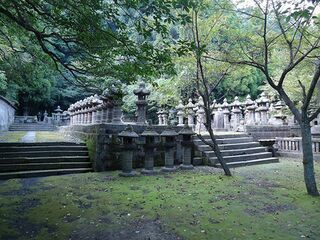Difference between revisions of "Shimazu Shigehide"
(Created page with "*''Born: '' *''Died: '' *''Japanese'': 島津重豪 ''(Shimazu Shigehide)'' Shimazu Shigehide was the 25th Shimazu clan lord of Satsuma province, known especially...") |
|||
| Line 1: | Line 1: | ||
| − | *''Born: '' | + | [[File:Shigehide.jpg|right|thumb|320px|Shigehide's gravesite at [[Fukusho-ji|Fukushô-ji]] in [[Kagoshima]], surrounded by tens of stone lanterns, is one of the largest in the entire [[Shimazu clan]] cemetery]] |
| − | *''Died: '' | + | *''Born: [[1745]]'' |
| + | *''Died: [[1833]]'' | ||
*''Japanese'': [[島津]]重豪 ''(Shimazu Shigehide)'' | *''Japanese'': [[島津]]重豪 ''(Shimazu Shigehide)'' | ||
| − | Shimazu Shigehide was the 25th [[Shimazu clan]] lord of [[Satsuma | + | Shimazu Shigehide was the 25th head of the [[Shimazu clan]] and eighth [[Edo period]] lord of [[Satsuma han]], ruling the domain from [[1755]] to [[1787]]. He is known especially for his support for [[Rangaku|Western Studies]], and for his relatively open policies regarding travel and exchanges between Satsuma and other [[provinces]]. Whereas travelers were generally not permitted to enter within the borders of the domain for much of the Edo period, during Shigehide's reign this was relaxed. |
| − | During the early years of | + | He was a son of [[Shimazu Shigetoshi]]. During the early years of Shigehide's reign, [[Shimazu Hisamoto]] served as an unofficial regent for the young ''daimyô''. |
| + | |||
| + | It is said that Shigehide desired to bring more commerce and trade into the domain, and believed that greater merchant activity was essential for a prosperous [[jokamachi|castle town]]; as a result, he relaxed the domain's strict border policies, known as the strictest in the realm, and sometimes even referred to as "the closed country within the [[sakoku|closed country]]."<ref>Gallery labels, [[Reimeikan Museum]], Kagoshima, Sept 2014.</ref> | ||
In [[1779]], he established an astronomical observatory and academy called the Meiji-kan; later renamed [[Tenmonkan]], this site grew to become the chief center of urban culture in [[Kagoshima]].<ref>Plaques on-site at Tenmonkan.</ref> | In [[1779]], he established an astronomical observatory and academy called the Meiji-kan; later renamed [[Tenmonkan]], this site grew to become the chief center of urban culture in [[Kagoshima]].<ref>Plaques on-site at Tenmonkan.</ref> | ||
| − | His concubines included [[Chima no kata]], eldest daughter of the court noble [[Tsutsumi Toshinaga]], whose direct descendants would include the famous [[Atsuhime]].<ref>Plaque at grave of Chima no kata, [[Shojoke-in|Shôjôke-in]], Teramachi-dôri, Kyoto.</ref> Shigehide's children included [[Kodai-in| | + | In [[1827]], he established a treasure museum within [[Satsuma Edo mansion|his Edo mansion]]. |
| + | |||
| + | His concubines included [[Chima no kata]], eldest daughter of the court noble [[Tsutsumi Toshinaga]], whose direct descendants would include the famous [[Atsuhime]].<ref>Plaque at grave of Chima no kata, [[Shojoke-in|Shôjôke-in]], Teramachi-dôri, Kyoto.</ref> Shigehide's children included his successor as lord of Satsuma, [[Shimazu Narinobu]] ([[1773]]-[[1841]]), as well as three other sons who were adopted into other ''daimyô'' families and became lords of their own domains. These were [[Shimazu Masataka]] (lord of [[Nakatsu han]] in [[Buzen province]], adopted by [[Okudaira Masao]]), [[Shimazu Narihiro]] (lord of [[Fukuoka han]], adopted by [[Kuroda Narikiyo]]), and [[Shimazu Nobuyuki]] (lord of [[Hachinohe han]], adopted by [[Nanbu Nobumasa]]). Shigehide's daughter [[Kodai-in|Shige-hime]], meanwhile, was married into the [[Tokugawa clan]], becoming the chief wife of [[Shogun]] [[Tokugawa Ienari]].<ref>''Kaiyô kokka Satsuma'' 海洋国家薩摩, Kagoshima: Shôkoshûseikan (2010), 58-59.</ref> | ||
| + | |||
| + | He is buried in the Shimazu clan cemetery at [[Fukusho-ji|Fukushô-ji]] in Kagoshima, alongside two of his wives, and his daughter [[Keihime]].<ref>Plaques on-site at Fukushô-ji.</ref> | ||
{{stub}} | {{stub}} | ||
Revision as of 01:24, 6 January 2015

Shimazu Shigehide was the 25th head of the Shimazu clan and eighth Edo period lord of Satsuma han, ruling the domain from 1755 to 1787. He is known especially for his support for Western Studies, and for his relatively open policies regarding travel and exchanges between Satsuma and other provinces. Whereas travelers were generally not permitted to enter within the borders of the domain for much of the Edo period, during Shigehide's reign this was relaxed.
He was a son of Shimazu Shigetoshi. During the early years of Shigehide's reign, Shimazu Hisamoto served as an unofficial regent for the young daimyô.
It is said that Shigehide desired to bring more commerce and trade into the domain, and believed that greater merchant activity was essential for a prosperous castle town; as a result, he relaxed the domain's strict border policies, known as the strictest in the realm, and sometimes even referred to as "the closed country within the closed country."[1]
In 1779, he established an astronomical observatory and academy called the Meiji-kan; later renamed Tenmonkan, this site grew to become the chief center of urban culture in Kagoshima.[2]
In 1827, he established a treasure museum within his Edo mansion.
His concubines included Chima no kata, eldest daughter of the court noble Tsutsumi Toshinaga, whose direct descendants would include the famous Atsuhime.[3] Shigehide's children included his successor as lord of Satsuma, Shimazu Narinobu (1773-1841), as well as three other sons who were adopted into other daimyô families and became lords of their own domains. These were Shimazu Masataka (lord of Nakatsu han in Buzen province, adopted by Okudaira Masao), Shimazu Narihiro (lord of Fukuoka han, adopted by Kuroda Narikiyo), and Shimazu Nobuyuki (lord of Hachinohe han, adopted by Nanbu Nobumasa). Shigehide's daughter Shige-hime, meanwhile, was married into the Tokugawa clan, becoming the chief wife of Shogun Tokugawa Ienari.[4]
He is buried in the Shimazu clan cemetery at Fukushô-ji in Kagoshima, alongside two of his wives, and his daughter Keihime.[5]
References
- ↑ Gallery labels, Reimeikan Museum, Kagoshima, Sept 2014.
- ↑ Plaques on-site at Tenmonkan.
- ↑ Plaque at grave of Chima no kata, Shôjôke-in, Teramachi-dôri, Kyoto.
- ↑ Kaiyô kokka Satsuma 海洋国家薩摩, Kagoshima: Shôkoshûseikan (2010), 58-59.
- ↑ Plaques on-site at Fukushô-ji.